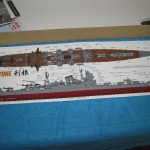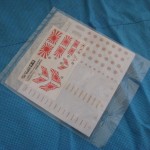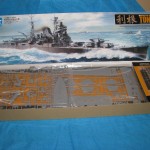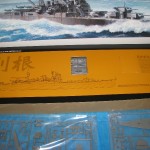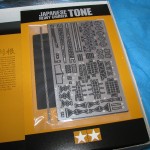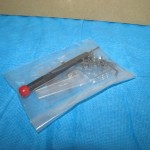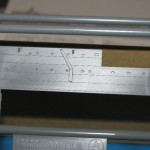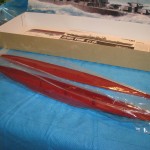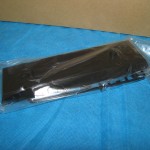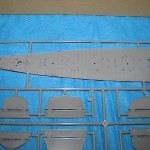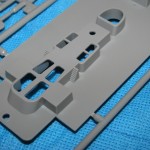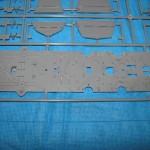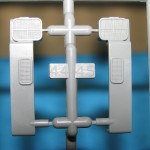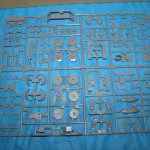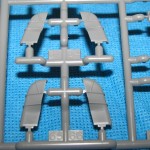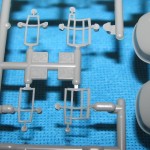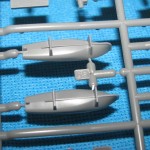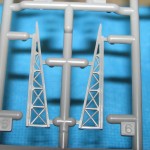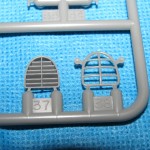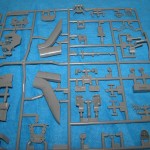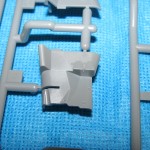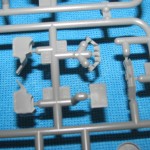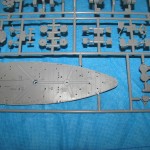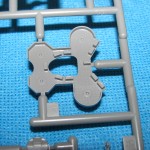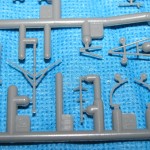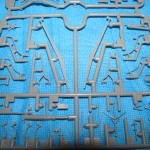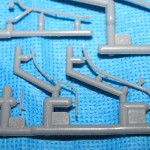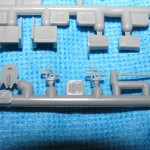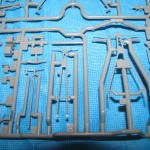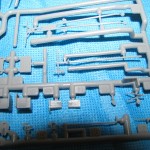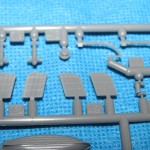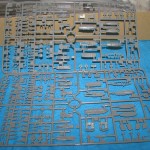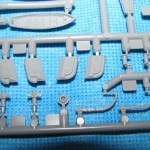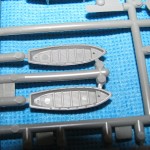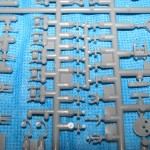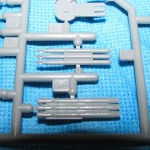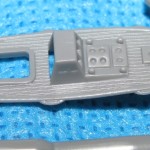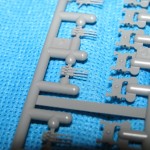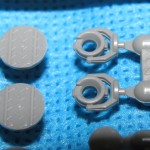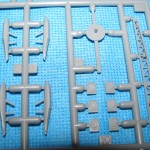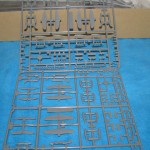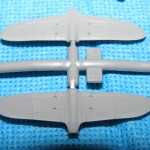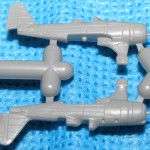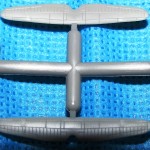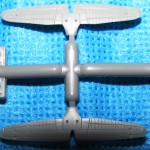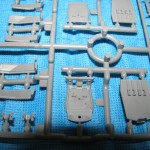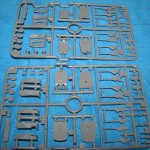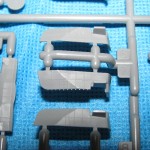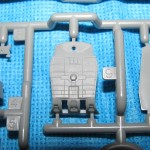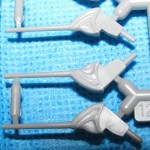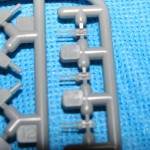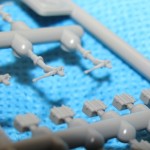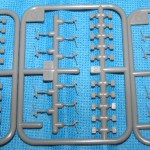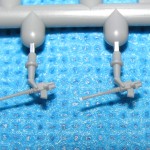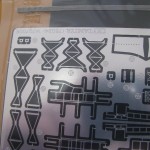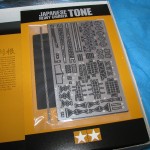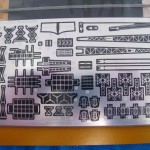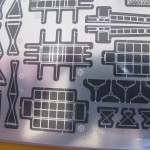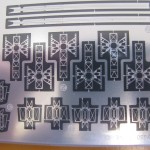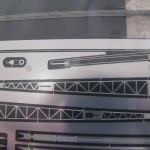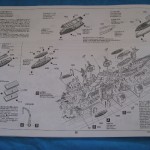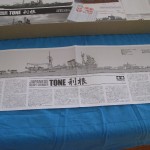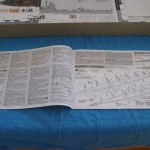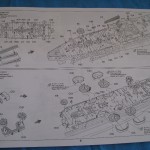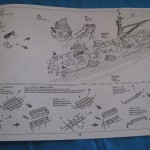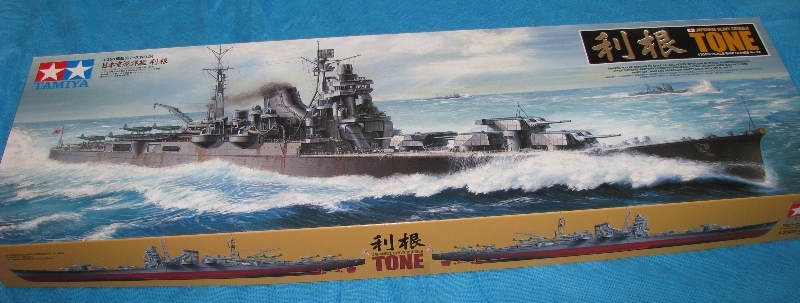 Review by Martin Quinn; May 2011.
Review by Martin Quinn; May 2011.
Laid down in 1934 as the next step in Japanese Cruiser design, the Tone and Chikuma were originally conceived as large light cruisers, with the same armament (6.1 inch guns) as were mounted on the Mogami-class. Early on in construction, Japan abrogated the London Naval treaty and the Tone-class was completed as heavy cruisers with 8 inch guns. Unlike the Mogami, which had her aircraft deck added after the damage she suffered at the Battle of Midway, the Tone class were designed to acts as scouts and to carry a large complement of floatplanes. This gave them their distinctive look with all four turrets forward of the superstructure and a large aircraft handling deck aft.
Tone served alongside Chikuma as part of the Cruiser Division 8 for most of her career. As the war in the Pacific began, CruDiv 8 participated in the Pearl Harbor raid and the capture of Wake Island. They also participated in the raid on Darwin, Australia and the sweep of the Java area in late February, 1942, when Tone helped sink the American destroyer USS Edsall (DD-219). Again escorting the carriers, CruDiv 8 was part of the Japanese March 1942 raid into the Indian Ocean. It was Tone’s scout plane that found the British cruisers HMS Dorsetshire and Cornwall, which led to their destruction by Japanese carrier aircraft. After the unsuccessful pursuit of Task Force 16 in the wake of the Doolittle Raid, Tone and Chikuma underwent a short refit at Maizuru.
Post-refit, CruDiv8 was part of Operation MI and the Battle of Midway, where Tone’s scout planes played a crucial role in the battle. A float plane that launched late found the American ships, but either didn’t recognize or neglected to report that one of those ships was a carrier. In a battle that is described in great detail elsewhere, the Japanese ended up losing four of their frontline carriers as well as their precious aircrews. As the Japanese fleet retired from the Midway debacle, CruDiv 8 was dispatched to support the Aleutian Island operations, in anticipation of an American counter-attack in that theater that never came.
Tone next saw action as part of the Japanese response to the American invasion of Guadalcanal. She and Chikuma escorted the carrier Ryujo during the Battle of the Eastern Solomons on August 24, 1942, escaping serious damage while Ryujo was sunk. In mid-October, Tone and a destroyer were sent to search for the American fleet, which did not appear, north of the Santa Cruz Islands. Later that month, on October 26th, her floatplanes spotted the American carrier Hornet during the Battle of Santa Cruz, which resulted in the Hornet being sunk.
After conducting support missions and patrols in the Solomons, Tone returned to Japan for a refit in February, 1943. During this time, her AA armament was upgraded slightly and radar was installed. Tone was part of the force assembled for the abortive mission to repulse the American attack on the Aleutian Islands. After ferrying troops and supplies to Rabaul, she was based out of Truk with other major units of the Imperial Navy. From here the Japanese sailed to respond – in vain – to American carrier raids on Makin in September and the Marshall Islands in October.
After a refit at Kure in December, 1943 – during which Tone’s AA fit was increased again – CruDiv 8 was disbanded. Tone and Chikuma were assigned to CruDiv 7 with the Kumano and Suzuya in January 1944. In March, Tone participated in the infamous Indian Ocean raid, where she sunk the British freighter SS Behar and executed 72 prisoners on board in retaliation for the merchantman sending a wireless raider report.
Tone was present for the Battle of the Philippine Sea, then returned to Japan for further upgrades to her AA and radar suites. Returning to the fleet, she moved between the Philippines and Singapore before participating in the Battle of Leyte Gulf, where she was damaged by US Navy carrier aircraft. After escaping further harm, Tone made her way back to Japan for repairs and further AA and radar upgrade in November. Due to the loss of Chikuma and Suzuya at Leyte Gulf, CruDiv 7 was disbanded and Tone was assigned to CruDiv 5 with the Kumano – who was soon sunk herself.
Tone spent the rest of the war moored near the Kure naval base. With fuel at a premium and the American fleet running amok in the Pacific, there was no place for her to go. Damaged by a carrier raid in March, 1945, Tone was finally sunk on July 24, 1945 by US carrier aircraft. Her hulk was raised and scrapped postwar.
Sources:
Cruisers of World War Two, MJ Whitley
Japanese Cruisers of the Pacific War, Lacroix and Wells
Tabular Record of Movement (TROM), Combined Fleet.com
CONTENTS
The kit comes in the standard Tamiya ship box. Included within are 16 plastic sprues, a lower hull for the full hull option, a waterline plate for the waterline option, one photo-etch set, one decal sheet, a display stand and a small bag with a screwdriver, poly caps and clear plastic parts. Also included are the instruction booklet Everything is sturdily packaged to avoid damage.
HULL/SPRUE A
Unlike many other manufacturers, and unlike their earliest 1/350 ship releases, Tamiya chooses to release their upper hulls as two piece affairs. Each half is very nicely molded, with bollards and chocks well rendered. As with their Mikuma kit, there is raised horizontal hull plating molded into the hull halves. The lower hull – which is one piece – is molded in red (do they think we don’t paint our models?) and like the upper hull, has faint longitudinal hull plating lines on it. These plating lines are not too heavy and should become even less pronounced after a coat or two of paint has been put on the hull. By my calculations, the hull scales out pretty much perfectly to the 650′ feet of the original, and ever so slightly beamier than the 63′ Tone actually was.
SPRUE B
This contains the foredeck, torpedo deck, main deck, hull stiffeners, props, struts and rudder (the struts are metal, and included in the bag with the poly caps and screwdriver). There is some nice detail to be found here – the foredeck appears to have a slight camber to it, which is a nice touch if my eyes aren’t playing tricks on me, and the strips which hold down the linoleum aren’t overstated. The diamond tread plating on the extreme forward section of this part is also well done. The torpedo deck – which will be barely visible through the openings in the side of the hull, has some aztec stairs and some other details cast into it. It’s a nice attempt at adding some detail, but aztec stairs? The main deck has the rails for the aircraft trolleys and the boat cradles molded into the deck. While some might prefer photo-etch cradles, I think these will do just fine, as you won’t really be able to see them under the boats anyway. It’s worth mentioning that the rudder has faint “plating” lines on it. Not sure how accurate this is, but it matches the rest of the hull.
SPRUE C
Contained on this sprue parts of the aft superstructure, barbettes for the turrets, ships boats, 12.7 AA platforms, safety stops for the 12.7 guns, directors, the aircraft ramp that leads from the main deck to the quarterdeck and the emergency rudder. The parts on the sprue are typical Tamiya quality, with the safety stops for the AA guns particularly nice. The aircraft ramp is pretty nicely rendered for plastic, which gives it a little more “depth” than photo-etch. Also, the detail on the grills for the vents is some of the nicest I’ve seen in this scale, and should really pop with a light wash.
SPRUE D
Found on this sprue is the funnel, funnel cap, parts of the forward superstructure, rangefinders and directors. The funnel has raised lines on it to represent the foot rails, but like the hull plating, these are understated and not too pronounced. The funnel cap consists of four pieces, two “inner” and two “outer” parts, which, when finished, will give the impression of baffles visible through the top cap. The tread plating on the AA gun platform on the front of the bridge is not quite as nice as that found on the Dragon Benson/Gleaves class kits, but it is very well molded. The lower parts of the directors have bracing on the undersides – a nice touch.
SPRUE E
The aft aircraft handling deck, additional parts of the bridge and various platforms (AA and otherwise) are found on this sprue. The holes for the various cable reels, AA gun platforms, etc. are integral to the deck, so if Tamiya is planning an early war Chikuma as a follow up to this kit, it will require a newly tooled deck. The AA platforms again have the tread plating, with the same quality as mentioned previously.
SPRUE F
Funnel piping, the injection molded parts of the aircraft handling crane, boat davits and parts of the mainmast comprise sprue F. The piping is very thin and looks in scale, I would just use caution when removing it from the sprue. As for the crane, it’s a hybrid of plastic and photo-etch, which will be covered in more detail in the photo-etch section below.
SPRUE G
On this sprue, you’ll find the foremast, mainmast, radar shack, as well as the Type 21 and Type 22 radars. Like the piping on Sprue F, the masts are finely reproduced and look “scale” to me. The more particular among us may want to replace them with brass for strength, but these should work well out of the box if you are not inclined to use brass rod. The Type 22 radars are quite nice, but the Type 21 radar is limited by the fact that it’s plastic. No matter how nicely it’s molded (and it is nice), it’s still a solid piece of plastic. On this sprue is part of the Type 13 radar, which is another “plastic/photo-etch hybrid” part.
SPRUE H x2
The pair of identical sprues labled H contain AA guns – both 25mm light and 12.7 heavy guns. There are also searchlights, searchlight towers, torpedo tubes, additional ships boats, paravanes, cable reels and smaller fittings such as davits and the free-standing binoculars for the lookout positions on the bridge. The 12.7 AA guns are multi-part items, with nice detail – the side pieces have the bracing molded into them. The triple 25mm AA guns are two pieces, and finely represented. Not as nice at the new Nano Dread items from Fine Mold, but more than serviceable for all but the most demanding modeler.
The searchlight towers are well done, though limited by the injection molded process, the might have been better represented by photo-etch, or as a “hybrid” plastic/photo-etch part. The platform that sits on top of the tower had really nice detailing on it. You’ll find the ships boats nicely detailed, with engraved planking inside the boats, though the cutters appear to have two shallow knock out marks inside of them.
SPRUE K x2
These two sprues hold two types of aircraft, plastic catapults and various smaller deck fittings. As with the crane and Type 13 radar, the catapults are a hybrid of plastic and photo-etch. This seems like it would have the advantage of giving more strength than a pure photo-etch part, especially in this scale, as well as providing more of a three dimensional look. I’m interested to see how they look once together.
The aircraft have finely done engraved panel lines, which will probably look less pronounced once painted. The canopies on the Jakes are molded as part of the aircraft, and interestingly enough have the canopy frames molded so that the windows are “recessed” to give more depth to this part. It is, of course, out of scale, but I think the affect will look interesting when painted.
SPRUE L x2
The turrets, turret rangefinders, gun barrels and blast bags, some additional light AA guns and additional cable reels are on these sprues. The blast bags are nice and when painted and give a light wash should look authentic. The turrets 5 parts each, and have raised panel lines on them. As mention elsewhere in this review, these are really nice and not too pronounced, and should (stop me if you’ve heard this before) look more subdued with a coat of paint on them.
Also found on this sprue are twin AA guns – I believe these to be 13mm guns, but by this point in her career, I don’t believe Tone carried those. As I don’t have the 8 inch gun Mogami class kit, I don’t know if this sprue is a carry over from that kit, or if this is an indication that an early war Chickuma may be forthcoming. Either way, these guns are very finely done, with very thin barrels.
SPRUE Y x3
These are smaller sprues which hold more light AA guns and ready ammo boxes for these weapons. The guns are extremely well molded, with detail that is very fine. As I mentioned before with the triple 25mm guns, these are not quite as nice as the Nano Dread weapons sets by Fine Molds, but nice nonetheless.
PHOTOETCH
Included with the kit is a single set of photo-etch. The relief etched set includes bracing, the photo-etch parts for the crane, which includes the pulleys, aircraft carts and trolleys, the “aircraft spare parts racks” and parts for the catapult. In an interesting move, Tamiya has included only some parts for both the catapults and crane in photo-etch. Instead of having a completely photo-etched item, these are plastic/photo-etch “hybrids”. They have done something similar with the Type 13 radar. There are, however, a few curious omissions: the Type 21 radar, the searchlight towers and all the inclined ladders are only available in injection molded plastic.
While I think the omission of the inclined ladders and Type 21 radar is a serious one, the set is very nicely done in stainless steel, with fine relief etching.
INSTRUCTIONS
The instructions are typical Tamiya. Well laid out, easy to read and to follow. What else is there to say?
CONCLUSIONS
This truly is the golden age of ship modeling, as we have been spoiled by one high quality release after the other – all of subjects never seen before in this scale and in this medium. On the heels of the recent Hasegawa Yahagi, the Dragon Scharnhorst and the Tamiya Mikuma comes another superbly done injection molded model. Tone is as nicely done as any injection molded model on the market today, which looks like it will build into a stunning representation right out of the box.
The Tone is kit number TAM78024, and has a suggested retail price of $191.99. That is a fairly large price tag for a heavy cruiser, but the price is in-line with what other manufacturers have asked for recent IJN heavy cruisers releases. You can also get it for less by shopping around with any number of vendors. My issues with the lack of photo-etch parts for the inclined railings, the searchlight towers and the Type 21 radar aside, this is an excellent kit. Highly Recommended. A big thank you to master modeler Dan Kaplan for the loan of the kit for this review.

